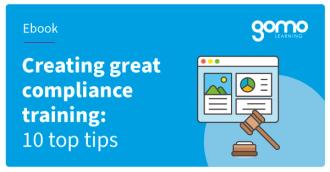4 learning design tricks that create better compliance eLearning
Though there’s certainly a good amount of unengaging, by-the-numbers compliance courses out there in the corporate world, smart eLearning authors know that this doesn’t always have to be the case. Compliance content can be just as interesting as it is important! Here are four simple ways to make courses people will want to take.
1) Focusing on behavior change
Great learning must be relevant, meaningful, and personalized if it’s going to get people’s attention. Focusing on behavior change means thinking learner-first: understanding where your learners are currently at, and the exact habits and practices they’re going to show when they fully internalize the training.
Talking practically, this means you’ll need to check in with your employees before you create your courses and your behavioral goals, in order to keep everything as relevant as possible. The course should communicate those goals, and once taken, you should revisit the conversation to find out where they’re now at. Along the way, you should take care to help learners understand why they should do something and why it should matter to them—many of the following points are critical to achieving this.
Uncover more great authoring tips. Read:
4 ways your eLearning design choices can save time and money.2) Telling a story
It’s no secret that stories create a strong emotional connection with learning. They allow learners to picture themselves in situations and better imagine how they would respond. Better still, stories in learning can take many different forms, all of which can work with compliance content.
One sure-fire way to make stories relatable is to use real employee experts and their experiences: even if the learner doesn’t know the expert personally (or even have the “seen them around the office” factor), real employees bring a level of authenticity that cannot be faked.
Of course, you may find that relevant employee experiences aren’t always easily available (or appropriate) for certain compliance topics. Regardless, the stories you create can still be grounded by familiar settings, or by having employees introduce them, act them out, or explain their importance.
Even in fully-fabricated scenarios, the effectiveness of your stories can be helped along by creating believable characters and settings.
Discover an example of a story-driven curriculum.
Read about Fidelity International’s Gomo-built courses here.3) Locking screens (but only when it’s essential)
One blunt-force way to guarantee engagement is to just make a piece of content impossible to skip. To be clear, it’s important to not frustrate your learners: you should only force learners to watch videos or interact with a piece of content when it’s meaningful to do so. Sometimes you’ll have learning messages that simply shouldn’t be skipped, and your eLearning authoring tool should support locking it down.
Find out how intuitive it is to lock screens in Gomo based on a range of conditions, including screen status, video progress, and asset correctness:
Read this blog post.4) Building a diagnostic testing structure
Compulsory content has its place. However, one of the best ways of increasing the effectiveness of compliance content is to go completely the other way, and make sure your learners see only the content that they absolutely need to see.
A diagnostic testing structure is ideal. Hit your learners with an assessment straight out the gate. Then:
- If they pass, perfect! They can review the modules if they want, but they’re compliant and they’re free to get on with their day.
- If they fail, the areas they haven’t understood are flagged and they are directed to the specific topics that they should revise.
Of course, you’ll need to invest time into making sure that your initial test is suitably rigorous. The goal isn’t to let everyone off—it should still be a good enough knowledge filter to ensure that people who need to learn the material are made to learn the material.
Continue learning about compliance content creation
This article features four tips from our full guide to getting compliance eLearning right, 'Creating great compliance training: 10 top tips'. The full guide considers 10 really simple things you can do to get important messages across—additionally concentrating on key format, scheduling, and promotional decisions that will help your work create real change in your organization!
Check it out below.
